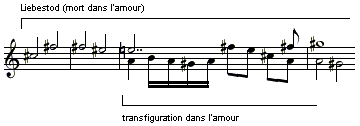Liebestod
"Liebestod" ([ˈliːbəsˌtoːt] German for "love death") is the title of the final, dramatic music from the 1859 opera Tristan und Isolde by Richard Wagner. When used as a literary term, liebestod (from German Liebe, love and Tod, death) refers to the theme of erotic death or "love death" meaning the two lovers' consummation of their love in death or after death. Other two-sided examples include Pyramus and Thisbe, Romeo and Juliet, and to some degree Wuthering Heights. One-sided examples are Porphyria's Lover and The Sorrows of Young Werther. The joint suicide of Heinrich von Kleist and lover Henriette Vogel is often associated with the Liebestod theme.

The aria is the climactic end of the opera as Isolde sings over Tristan's dead body.
Partial text
|
Mild und leise |
Softly and gently |
Adaptations
Mild und leise is also the title of an 18-minute synthesized composition by Paul Lansky, made in 1973 on an IBM 360 mainframe. Parts of it became the foundation for Radiohead's song "Idioteque".
References
- Elisabeth Bronfen , Liebestod und Femme fatale. Der Austausch sozialer Energien zwischen Oper, Literatur und Film, Frankfurt am Main: Suhrkamp 2004. ISBN 3-518-12229-0
External links
- "Isolde's Liebestod", act 3, complete score and transcriptions: Scores at the International Music Score Library Project
- Full text and some performances
| ||||||||||||||||||||||||||||||